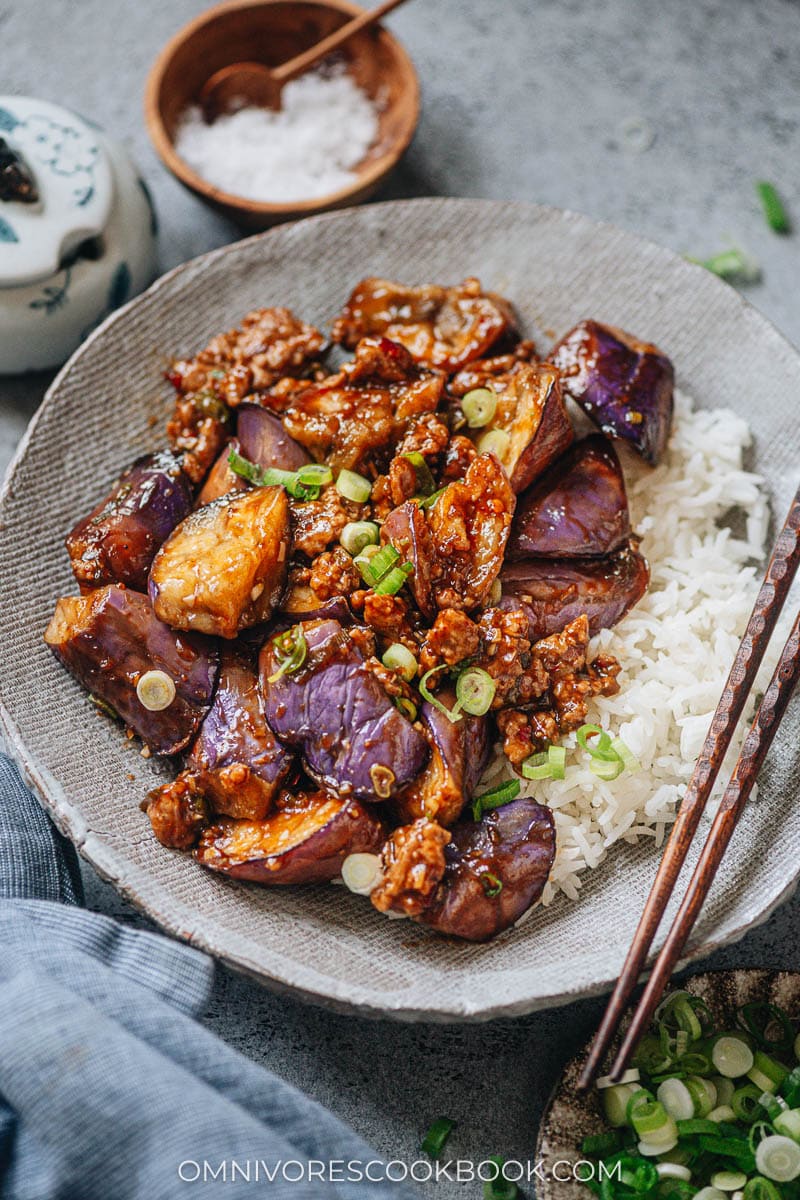
Yu Xiang eggplant (鱼香茄子), or Sichuan eggplant stir fry, is one of those under-appreciated Sichuan dishes that deserves more attention. Throughout the years, whenever I took a foreign friend or colleague to a Sichuan restaurant in Beijing, this dish was always one of the most popular Chinese vegetable stir fry recipes on the table.
What is yu xiang?
Yu xiang literally translates as “fish-fragrant” in Chinese, which might not sound as appetizing as the dish tastes.
In fact, fish-fragrant eggplant has nothing to do with fish.
According to folklore, a housewife was cooking eggplant for dinner and did not want to waste the leftover sauce used in a fish dish. The sauce was designed to cover up the fishiness and muddiness of river fish, so it was extra fragrant. The dish turned out so well and her husband loved it more than the original fish dish. Thus, the dish was named yú xiāng or “fish-fragrant” as an homage to the delicious sauce.
Yu xiang flavor is one of the seven key flavors in Sichuan cuisine. It contains soy sauce, Chinkiang vinegar, sugar, fermented spicy bean paste (dòubànjiàng), chili peppers, and a generous amount of fresh garlic, ginger and onion. It results in a well-balanced, sweet and sour spicy sauce that is bursting with umami. The taste might be considered similar to General Tso’s sauce, only 10 times more flavorful.
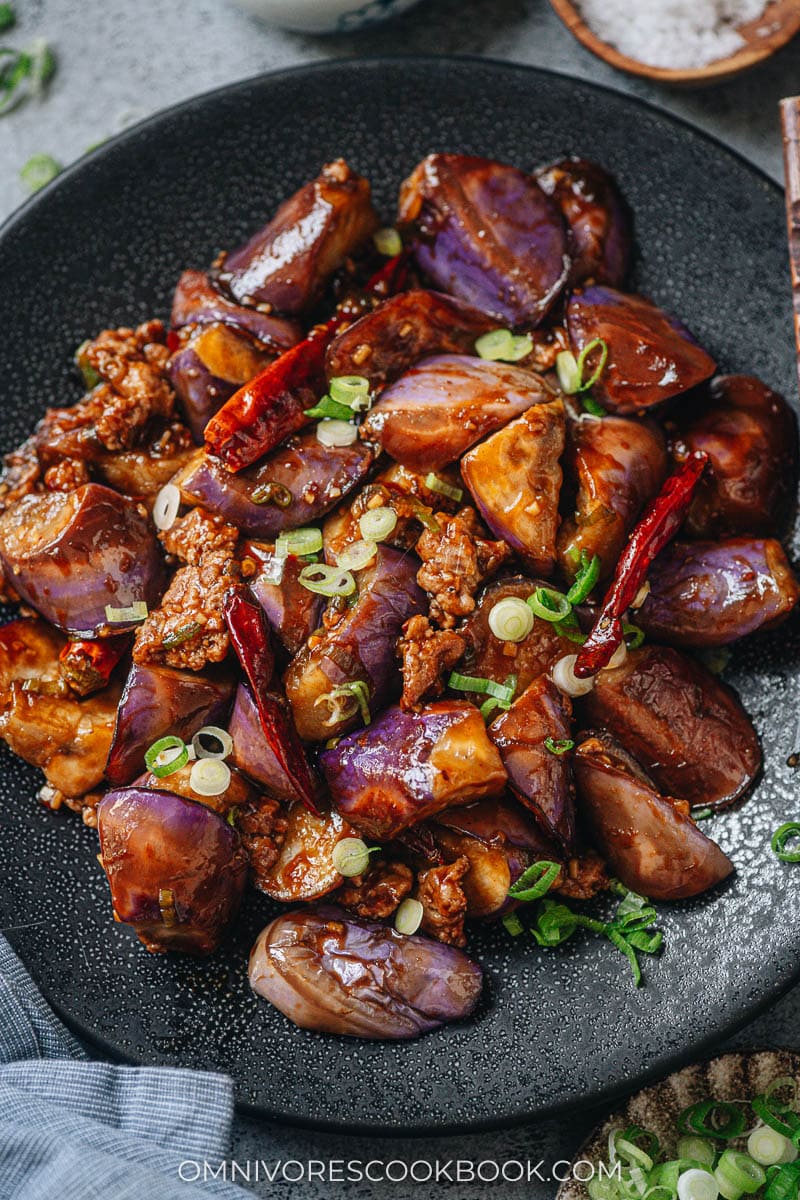
Yu xiang eggplant ingredients
What type of eggplant to use
The best eggplant for making yu xiang eggplant is Chinese eggplant or Japanese eggplant (they are very similar).
The long and skinny Asian eggplant contains less moisture than the Western type, which results in a crispier texture in the stir fry. However, you can also use Western eggplant by following the salt water soaking method in this recipe.
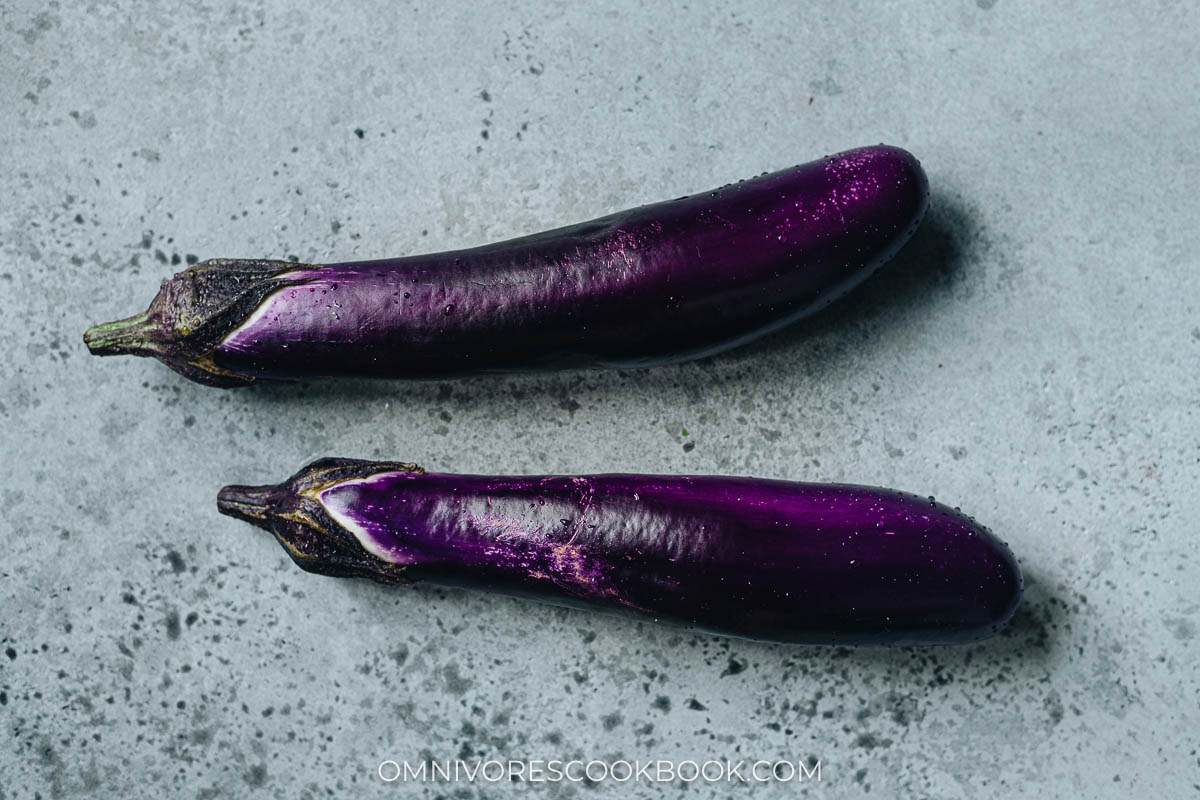
The best vinegar to use
Some yu xiang eggplant recipes call for rice vinegar. But if you really want the rich tangy taste like the restaurant version has, you should use Chinkiang vinegar instead.
Chinkiang vinegar (Zhenjiang vinegar, 镇江香醋) is a type of Chinese black vinegar. It is made from various grains and is aged until the color turns dark brown or inky black. It has a rich, pungent, and tart flavor, sometimes with a hint of sweetness. It has a fermented malty taste and a woody character that distinguish it from the light-colored and fruity rice vinegar.
These days it’s quite easy to find it in an Asian market and even at regular grocery stores. You can also shop for it on Amazon.
Doubanjiang
Doubanjiang (豆瓣酱), also called fermented spicy bean paste, is a key ingredient for the ultimate umami. It is a super rich, fermented, spicy paste made with dried fava beans, fresh chili peppers, salt, and wheat flour, then aged for one to eight years. Doubanjiang has a deep savory, spicy, and quite salty taste. It is a key ingredient in classic Sichuan dishes such as Mapo Tofu.
You can find it in an Asian market, on Amazon, or at Mala Market.
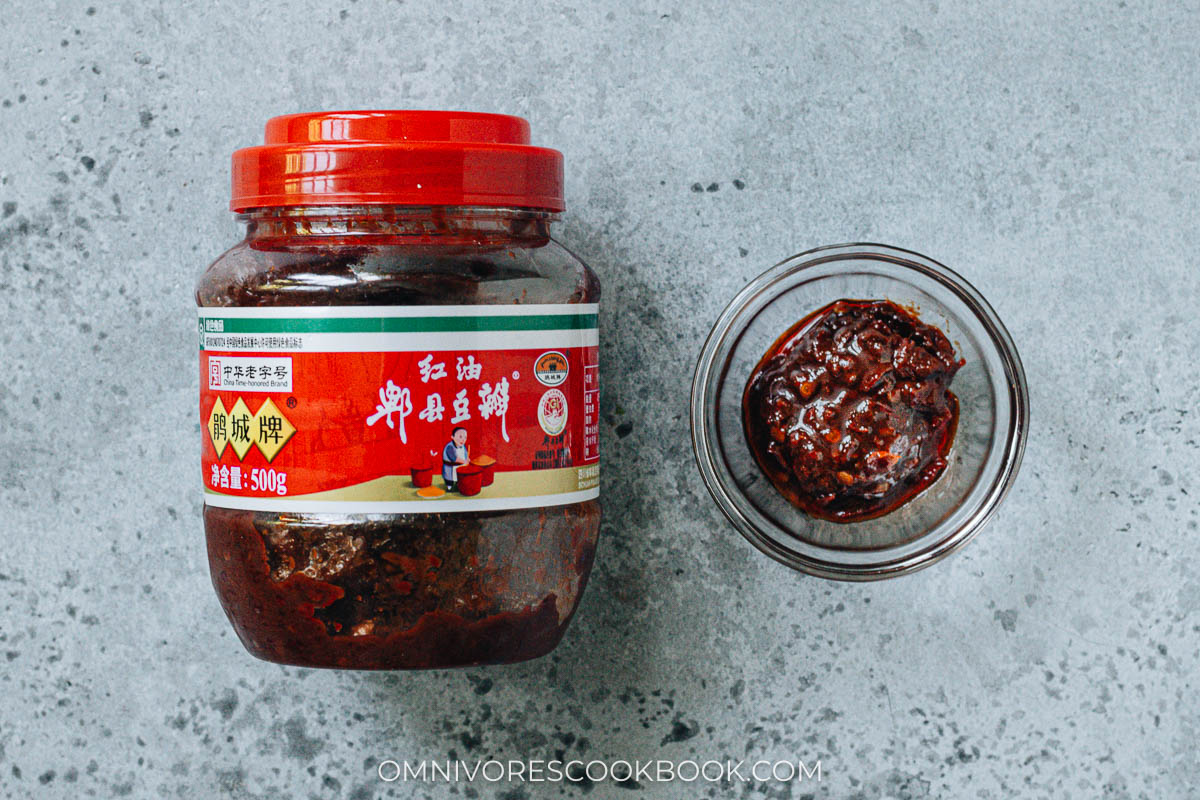
Sichuan peppercorns
Sichuan peppercorn (Hua Jiao, 花椒) is optional but I highly recommend adding it if you have it on hand. The taste of fresh Sichuan peppercorn is almost indescribable: numbing, tingling, and somewhat refreshing like mint. These peppercorns add a savory, smoky, and slightly citrusy flavor to a dish, and it’s that flavor that defines genuine Sichuan food. I consider it even more important than Sichuan chili peppers, truly distinguishing the dish and giving it a character unlike anything else. It’s a key ingredient in many classic Sichuan dishes such as Dan Dan Noodles, Mala Chicken, and Red Oil Wontons.
I highly recommend you purchase Sichuan peppercorns from Mala Market. They carry the freshest Sichuan peppercorns in the US, sourced directly from Sichuan. It truly makes a world of difference.
Mise en place
When you’re ready to cook yu xiang eggplant, your table should have:
- Mixed sauce
- Ground meat
- Aromatics (ginger, garlic, green onion)
- Sichuan spices (Doubanjiang, Sichuan peppercorns, dried chili pepper)
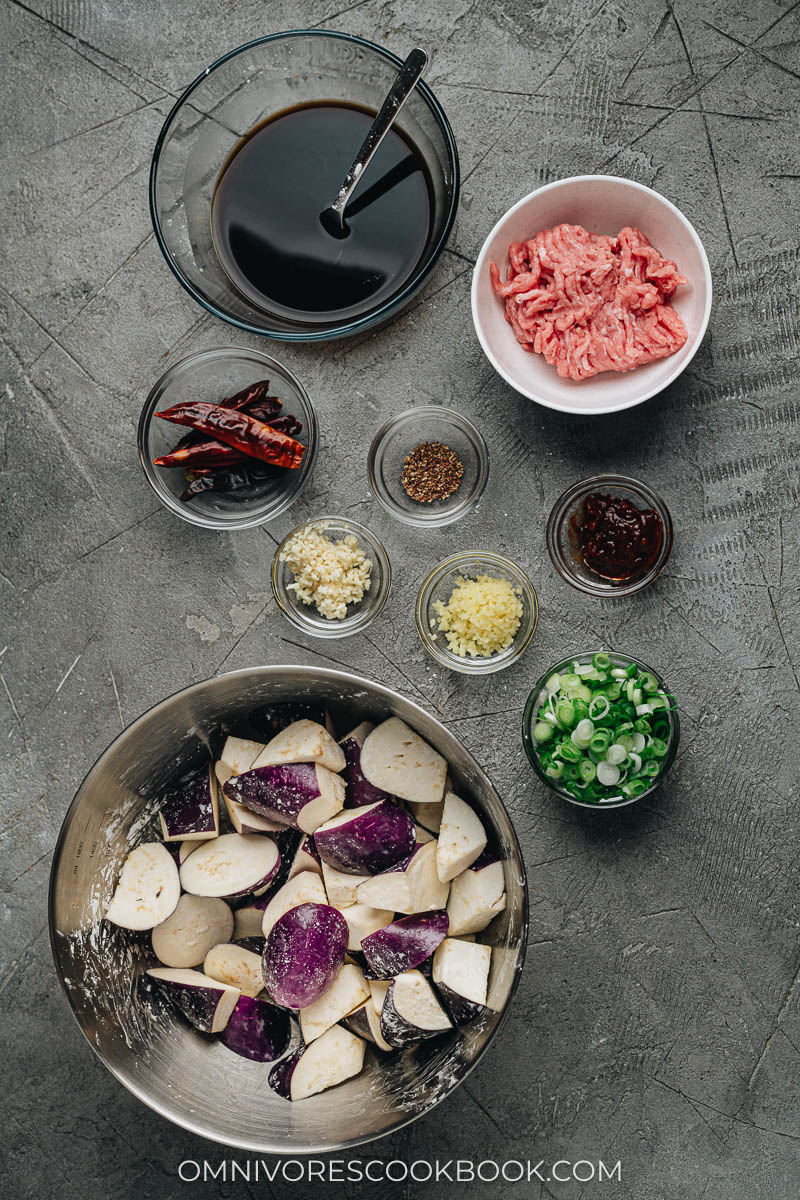
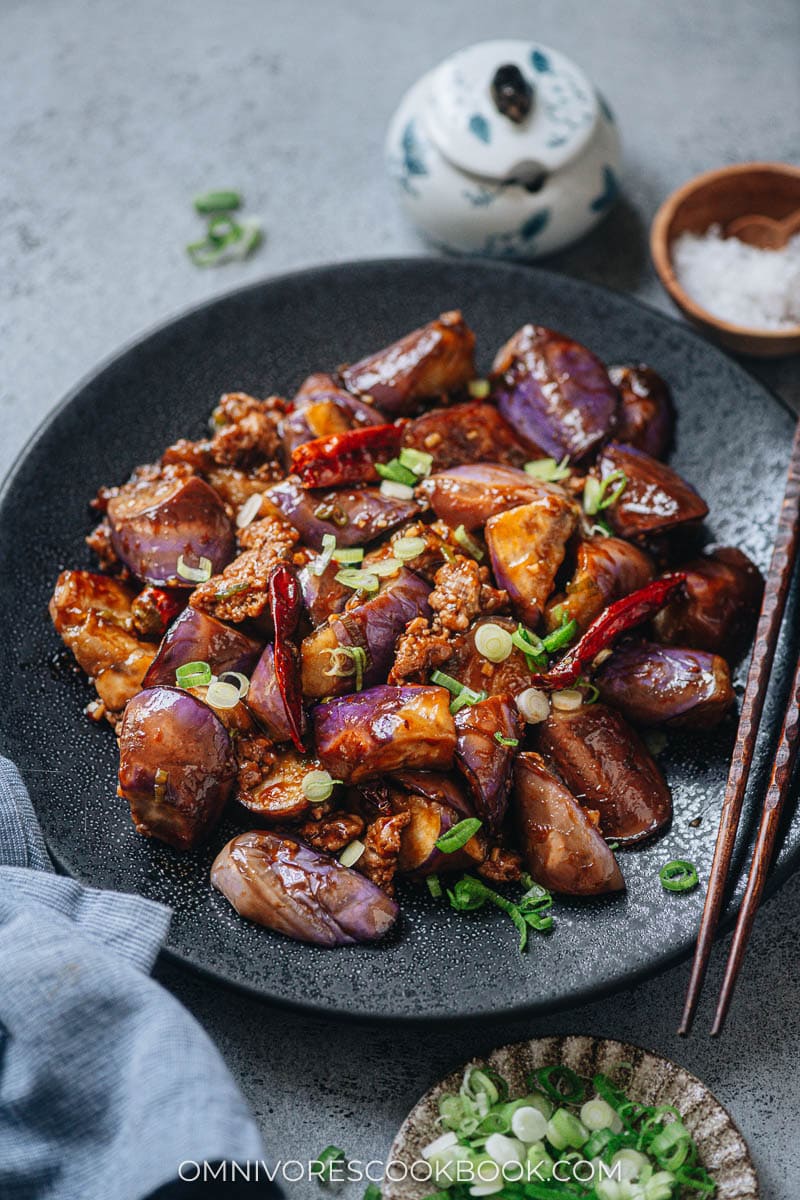
How to make yu xiang eggplant
- Pan fry the eggplant until crispy
- Sear the ground meat
- Add the aromatics
- Cook with doubanjiang and Sichuan peppercorn
- Thicken the sauce
- Add the cooked eggplant back in
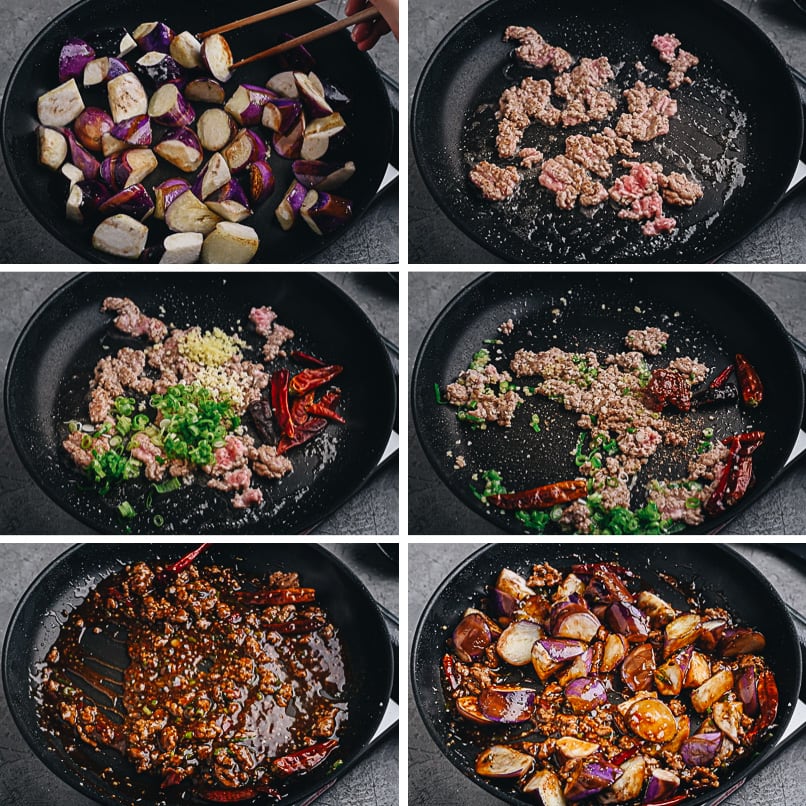
The secret to cooking perfect eggplant on the stovetop
Eggplant is one of the trickiest vegetables to cook with, though the result is super rewarding if you do it right. In the past, I’ve discovered the method of creating crispy eggplant on the stovetop without deep-frying. The key is to marinate the eggplant in salted water and then dust it with cornstarch before searing it on a flat-bottom pan. You can read my Chinese Eggplant with Garlic Sauce recipe to view the details.
With this technique the eggplant pieces turn out extra crispy with a tender inside. Better still, you can use regular Western eggplant instead of Asian eggplant, and it will work perfectly!
It proves again that you can cook perfect yu xiang eggplant if you follow the right method. Next time you don’t need to make the extra trip to the Asian market to make this hearty dish.
How to keep the purple color of the eggplant?
The yu xiang eggplant from a Chinese restaurant has a beautiful bright purple color. It is achieved by flash frying (过油, Guo You) – the eggplant pieces are quickly fried in a pool of oil in a wok, until the outside is crispy and the inside is al dente. Many dishes use this method to preserve the color of the vegetable while maintaining a great texture.
I do not use the flash frying method at home because it requires a lot of oil. It is quite messy for a home kitchen, and creates a lot of smoke.
The pan frying method cuts the oil to a minimum, and the result is still great. To preserve the eggplant color, try cooking the eggplant until al dente instead of turning tender fully, for the best color.
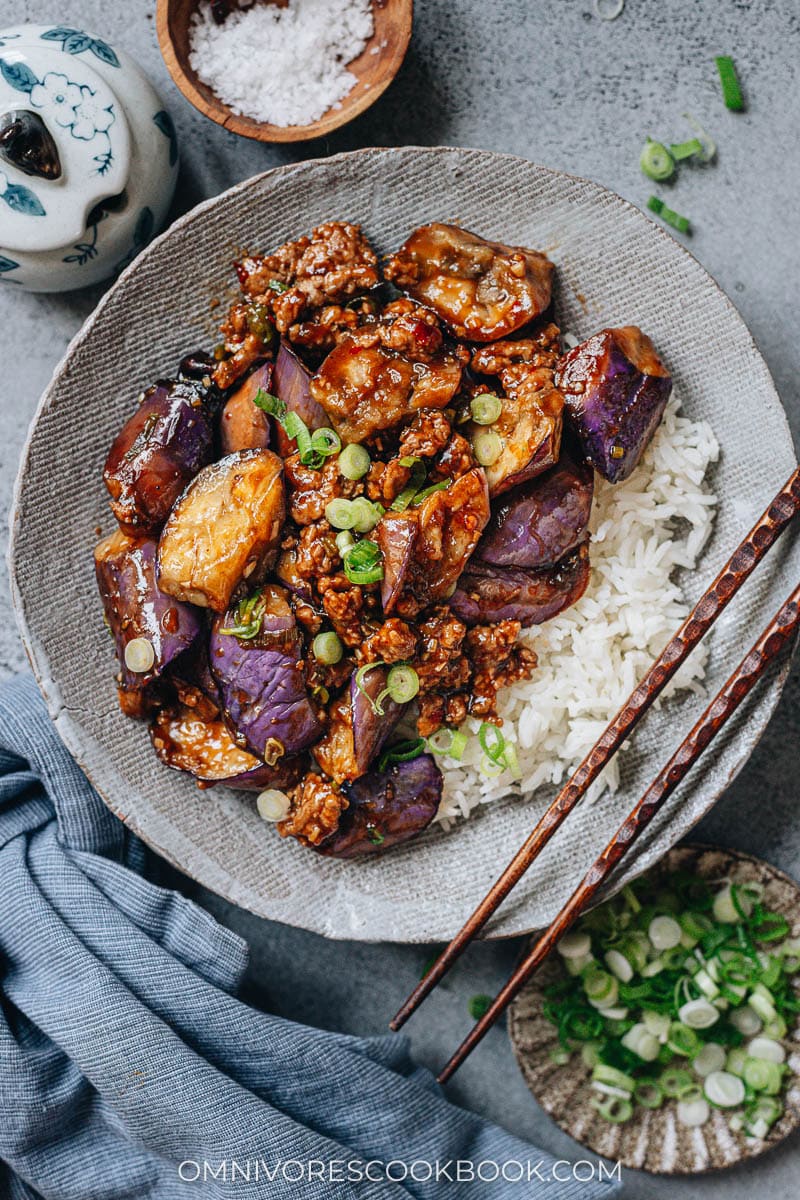
How to serve yu xiang eggplant
Yu xiang eggplant is a very satisfying dish that you can serve as a main dish over steamed rice. In China, this one is a lunch set menu favorite!
Of course you can also serve yu xiang eggplant as part of a multi-course meal. For a full-on Sichuan dinner, serve this one along with dishes such as Pickled Cabbage, Mala Chicken (La Zi Ji), Dry Fried Green Beans, Dan Dan Noodles, and Stir Fried Pea Shoots.
More vegetable main dishes
- Chinese Eggplant with Garlic Sauce
- Di San Xian (Fried Potato, Eggplant and Pepper in Garlic Sauce 地三鲜)
- General Tso Tofu (Crispy Tofu without Deep Frying)
- Chinese Vegetarian Noodle Soup
- Vegetarian Chow Mein
Chinese Cooking Made Easy
Are you new to this website? This free email series is a great place to start. I’ll walk you through a few of my most popular recipes and show you how and why they work. You’ll quickly start to cook better Chinese food in your own kitchen.
Watch video
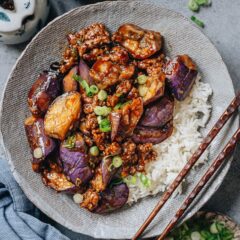
Yu Xiang Eggplant (鱼香茄子, Sichuan Eggplant Stir Fry)
Ingredients
- 2 Chinese eggplant , cut to bite-sized pieces (or regular eggplant) (*Footnote 1)
- 1 teaspoon salt
- 2 teaspoons cornstarch (to coat the eggplant)
Sauce
- 2 tablespoons Chinkiang vinegar
- 1 1/2 tablespoons light soy sauce (or soy sauce)
- 1 tablespoon Shaoxing wine (or dry sherry)
- 2 tablespoons sugar
- 1/4 cup chicken stock (or vegetable stock)
- 2 teaspoons cornstarch
Cook
- 3 tablespoons peanut oil (or vegetable oil)
- 4 oz ground pork (or chicken) (*Footnote 2) (Optional)
- 2 green onions , sliced
- 2 cloves garlic , minced
- 1 tablespoon ginger , minced
- 8 to 10 dried Chinese chili peppers
- 2 teaspoons doubanjiang
- 1/4 teaspoon ground Sichuan peppercorn (Optional)
Instructions
- Place eggplant in a large bowl and add water to cover. Add 1 teaspoon salt, mix well. Place a plate on top so the eggplant pieces are submerged in the water. Let sit for 10 to 15 minutes while preparing the other ingredients. Once done, drain and pat dry with paper towels.
- Add all the sauce ingredients into a bowl. Stir to mix well.
- Sprinkle eggplant with cornstarch and mix by hand, until eggplant is evenly coated.
- Add 2 tablespoons of the oil to a large skillet and heat over medium-high heat until hot. Spread eggplant across the bottom of the skillet without overlapping. Cook the eggplant, stirring occasionally, until the edge of the eggplant is lightly charred and the texture just starts to soften, 5 minutes or so. Transfer to a plate. If the skillet gets too hot and starts to smoke, turn to medium heat.
- Add the remaining 1 tablespoon of oil and the ground meat. Cook and chop the pork into smaller pieces, until fully cooked.
- Add green onion, garlic, ginger and chili pepper. Stir a few times to release fragrance.
- Add the doubanjiang and Sichuan peppercorns. Stir and cook until the pork is evenly coated.
- Stir the sauce again to completely dissolve the cornstarch, then pour into the pan. Stir until the sauce thickens. Return the eggplant to the pan and quickly stir to mix everything well. Serve hot as a main dish or side dish.
Notes
- Long Asian eggplant (Chinese or Japanese eggplant) works the best and the soaking step can be skipped if you are using one of those two kinds. You can use regular Western eggplant instead. But make sure you use the salt soaking method if using regular eggplant.
- You can skip the ground meat to make a vegan dish and the sauce will still be very tasty.
Nutrition

Did you make this recipe?
I’d love to hear how it turned out for you! Please take a moment to leave a 5-star rating ⭐️ and share your thoughts in the comments further down the page. It really helps others discover the recipe too.

Voni
I have made this dish 4x. I tweeked it a bit. I steamed everything instead of frying. I add snowpeas, carrots and shrimp. Today I will fry the eggplant to see the results. It’s the best sauce ever!
Gita
Maggie, this recipe was outstanding! Totally delicious. Thank you for posting. I look forward to trying more recipes from your website. 🙂
M
This recipe looks great. Question about doubanjiang substitutions – would hoisin sauce, broad bean paste, or chili bean paste work instead? Thank you!
Maggie Zhu
Chili bean paste would work pretty well. I’m not sure about the type of broad bean paste you’re using because it can be a translation of doubanjiang. But it won’t work if it’s the non-spicy salty type.
mc
Super delicious recipe – it helped me use up that odd eggplant I had in the fridge. Thank you!
CO Lee
This was delicious. And relatively easy.
I will absolutely make this many times more!
Sol
I usually never leave reviews, but Ive been following your recipes quite a while and this…I made this yesterday. IT WAS AMAZING!!
Ins Woodruff
In 2003 we spent our first summer in China teaching conversational English. We fell in love with “fish-taste eggplant” and ate it almost every day. I’ve never found it at a Chinese restaurant in the states, but it I can find all the ingredients it’s about to be cooked in the southern part of Georgia.
Bob
This is better than at the best Szechuan place in the city. The real deal paste makes a huge difference, and I was fortunate to find Pixian locally. We’ve made this twice in a few days now, and it’s just mind-blowing.
Melané Fahner Botha
Great recipe! I replaced the pork with chopped and boiled tempeh (my favorite meat replacement) and it was luuuuuvly! We are great fans of the Sichuan cuisine and this ticked all our boxes including the one titled “learn how to appreciate egg plant”! Thank you for your work!
Ultraeye
Every guest tells me its better than they have ever had in a restaurant
Ile
Can i fry the eggplant earlier (morning) and then just finish with sauce before dinner? Or it will get soggy?
Maggie
The eggplant will get soggy but pan fry them before adding the sauce will help crisp up the eggplant again. Also, you can store the eggplant by spreading them out on a big plate and cover loosely with kitchen paper towels. It helps the batter stay dry, which result in a better texture than refrigerate them. Happy cooking and hope your dish turns out well 🙂
MikeW
Made this for the 1st time, won’t be the last though
Patrice
This recipe was better than restaurants! It turned out spectacularly. Thanks for the tips on how to keep the eggplant crispy.
Jennifer Priest
Even my eggplant -hating husband loves this!
Heather B
I’ve been making this recipe for the past 8 months and my whole family loves it. We make it without the pork as we don’t eat it. Yesterday, for the first time, I was able to harvest and use Asian eggplant from my own garden that I grew specifically with this dish in mind. Absolutely incredible!
Maggie
Hi Heather, I’m glad to hear you like the dish and it’s amazing you grew some Asian eggplant for it 🙂
Thanks for leaving a good review!
Bill Zigrang
Maggie,
Please note that, in the revised version, you did not mention when to return the toasted Sichuan peppercorns to the dish.
William Zigrang
??Or are they just meant to flavor the oil??
BZ
Maggie
The Sichuan peppercorns are added in the recipe to infuse the oil. And you can see in footnote 3 on how to use them later. You can grind them up and use in other dishes.
Janet C
Maggie,
This is the 1st time I cooked this dish following your recipe as much as possible. I left out the chillies because of my son but added chillie into mine. I wasn’t too sure if he will eat the eggplant but he ate up every bit of it. So thank you very much for your recipe.
Janet C
Laurel
With rice, a complete dinner by itself. As with much Asian inspired cooking the prep takes the most time and is crucial to have everything ready to go. The video was especially helpful for me to see the sizes and shapes to cut everything. The sauce turned out silky and flavorful. The final dish was rich and filling.
Sabrina
This was very delicious – eggplant flavors were just what I wanted. However, I think I used too much corn starch and it came out too gloppy and made the dish heavy. To be more healthy, I might use less sugar next time at well – hope it doesn’t change the flavors too much. I also will try using less oil – or using it in divided portions – I put in all the oil in the beginning and the early eggplants were cooked similar to a deep-fry technique!
wo
i just made this dish. simplified it a bit to make it one process pot. do not skimp on the sichuan pepper. i added double and it tastes amazing flubble wubble